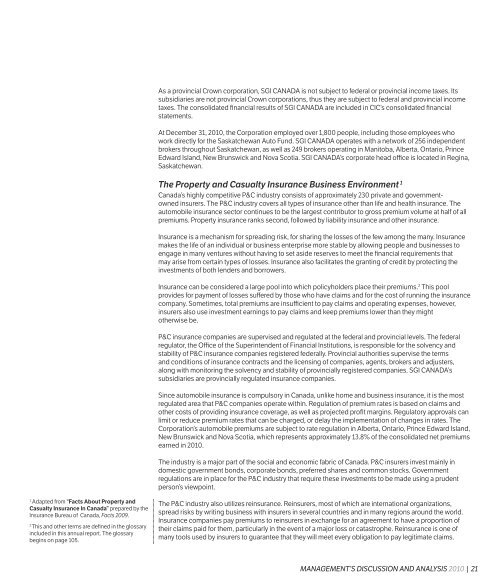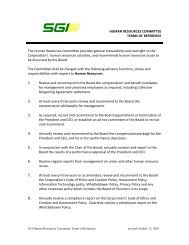Full report - SGI Canada
Full report - SGI Canada
Full report - SGI Canada
Create successful ePaper yourself
Turn your PDF publications into a flip-book with our unique Google optimized e-Paper software.
The asset mix strategy is formally documented in the Statement of Investment Policies and Goals. In<br />
addition to capturing the asset mix strategy, this document provides guidance on permissible investments,<br />
quality and quantity guidelines, conflicts of interest, related party transactions and investment<br />
performance expectations, among others. Management monitors and enforces compliance with the<br />
investment policy. No material compliance deviations were noted in 2010.<br />
The Corporation’s investment portfolio is managed by external investment managers. The portfolio is<br />
invested in short-term investments, bonds, mortgages and equities. Equities consist of Canadian, U.S. and<br />
non-North American equities. The Corporation’s subsidiaries hold their Canadian and U.S. equities through<br />
pooled funds, while all the Corporation’s non-North American equities are held through a pooled fund.<br />
<strong>SGI</strong> CANADA Asset Mix<br />
As at December 31<br />
The investment policy review in 2010 resulted in changes to the policy asset mix guidelines and<br />
benchmark portfolio weights for the <strong>SGI</strong> CANADA, <strong>SGI</strong> CANADA Insurance Services Ltd. and Coachman<br />
investment portfolios. The fixed income portfolios within these companies were restructured to better<br />
match investment assets to their associated liabilities and to reduce potential interest rate risk. For<br />
<strong>SGI</strong> CANADA, the half of the fixed income portfolio holding long-term bonds was sold and subsequently<br />
reinvested in bonds with shorter maturities as well as higher allocations to cash. Similarly in <strong>SGI</strong> CANADA<br />
Insurance Services Ltd., longer-term bonds were sold and reinvested in short-term bonds and cash,<br />
although with significantly higher allocations to cash due to its surplus of bond assets over its associated<br />
liabilities. The Coachman fixed income portfolio was previously fully invested in short-term bonds, but it<br />
was also determined to have surplus bond assets over its liabilities allowing for higher allocations to cash.<br />
In all cases, the restructured portfolios showed better alignment between bond assets and interest rate<br />
sensitive liabilities. The ICPEI portfolio required no changes in 2010 due to its already close alignment<br />
between its assets and liabilities.<br />
Cash and cash equivalents<br />
Cash and cash equivalents at December 31, 2010, was $27.8 million (2009 – $16.9 million), an increase<br />
of $10.9 million. The sources of the change in cash and cash equivalents for the year are discussed in<br />
the above section Consolidated Statement of Cash Flows. Cash equivalents consist of money market<br />
investments such as treasury bills, banker’s acceptances, discount notes or other liquid short-term<br />
investments that have a maturity of 90 days or less from the date of acquisition.<br />
Deferred policy acquisition costs<br />
Deferred policy acquisition costs increased $3.8 million during the year. The increase is due to an increase<br />
in prepaid commissions and prepaid premiums, a direct result of increased premium volume.<br />
Accounts receivable<br />
Accounts receivable increased $2.1 million, largely a result of a $12.0 million increase in financed premiums<br />
receivable. The increase is commensurate with the growth in premiums written. Offsetting this increase<br />
are investment proceeds receivable of $12.3 million outstanding at the end of 2009 related to investment<br />
transactions in progress. There were no investment transactions in progress over the 2010 year end.<br />
Additionally of note is an increase of $1.5 million included in amounts due from brokers for loans issued<br />
during the year related to the sale of its equity accounted investments. These investments were related to<br />
the Corporation through the minority shareholder in ICPEI. These loans are described in detail in note 17 to<br />
the financial statements.<br />
2010 2009 Change<br />
(thousands of $)<br />
Total liabilities $ 632,070 $ 599,246 $ 32,824<br />
Non-controlling interest 2,428 1,879 549<br />
Key liability account changes:<br />
Unearned premium 242,497 218,893 23,604<br />
Provision for unpaid claims 316,820 293,575 23,245<br />
Dividend payable 15,462 22,199 (6,737)<br />
Accounts payable and accrued<br />
liabilities 29,292 39,476 (10,184)<br />
Unearned premiums<br />
Unearned premiums increased $23.6 million, a direct result of growth in premiums written.<br />
42 | 2010 MANAGEMENT’S DISCUSSION AND ANALYSIS MANAGEMENT’S DISCUSSION AND ANALYSIS 2010 | 43















